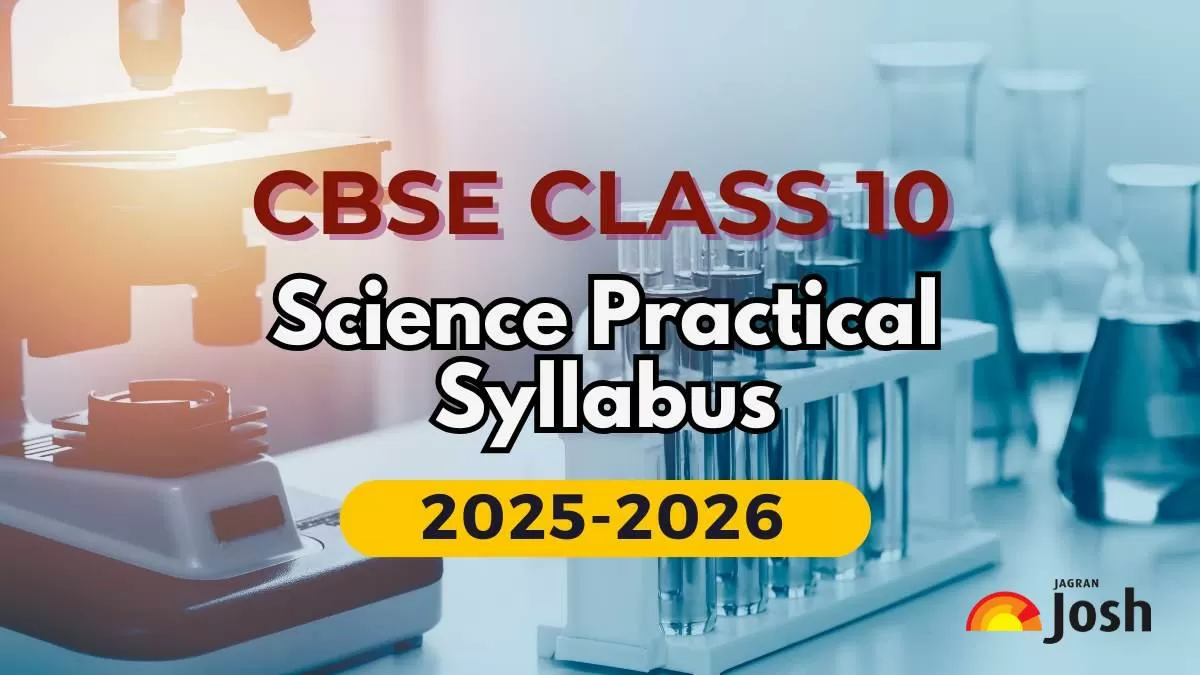Class 10 Science Practical Syllabus 2025-26: The CBSE Class 10 Science Practical syllabus for 2025–26 is thoughtfully designed to bridge the gap between theory and application. With its balanced focus on experimentation, observation, and inference, it not only supports academic performance but also nurtures a scientific attitude in students. By actively engaging in the prescribed practicals and maintaining a strong lab record, students can boost both their internal assessment scores and conceptual understanding. Mastering these practicals will also lay a strong foundation for advanced science learning in higher classes.
Key Highlights of Class 10 Science Practicals 2025–26
-
Total Internal Assessment Marks: 20
-
Periodic Assessment – 10 Marks (5 + 5)
-
Practical Work / Subject Enrichment – 5 Marks
-
Portfolio – 5 Marks
-
-
Number of Experiments: 15 experiments across Physics, Chemistry, and Biology
-
Assessment Emphasis:
-
Observation and reporting
-
Experimental accuracy
-
Record-keeping and practical file
-
Analytical thinking and interpretation
-
Also Check| CBSE Class 10 Science Theory Syllabus 2025-26
To know the complete list of Class 10 Science experiments, scroll down below. You can also find the link to download the full practical syllabus PDF at the end of the article.
List of Experiments - CBSE Class 10 Science
-
A. Finding the pH of the following samples by using pH paper/universal indicator: (Unit I)
a) Dilute Hydrochloric Acid
b) Dilute NaOH solution
c) Dilute Ethanoic Acid solution
d) Lemon juice
e) Water
f) Dilute Hydrogen Carbonate solutionB. Studying the properties of acids and bases (HCl & NaOH) on the basis of their reaction with: (Unit I)
a) Litmus solution (Blue/Red)
b) Zinc metal
c) Solid sodium carbonate -
Performing and observing the following reactions and classifying them into: (Unit I)
a) Combination reaction
b) Decomposition reaction
c) Displacement reaction
d) Double displacement reaction-
Action of water on quicklime
-
Action of heat on ferrous sulphate crystals
-
Iron nails kept in copper sulphate solution
-
Reaction between sodium sulphate and barium chloride solutions
-
-
Observing the action of Zn, Fe, Cu and Al metals on the following salt solutions: (Unit I)
a) ZnSO₄ (aq)
b) FeSO₄ (aq)
c) CuSO₄ (aq)
d) Al₂(SO₄)₃ (aq)-
Arranging Zn, Fe, Cu and Al (metals) in the decreasing order of reactivity based on the above result.
-
-
Studying the dependence of potential difference (V) across a resistor on the current (I) passing through it and determine its resistance. Also plotting a graph between V and I. (Unit IV)
-
Determination of the equivalent resistance of two resistors when connected in: (Unit IV)
-
Series
-
Parallel
-
-
Preparing a temporary mount of a leaf peel to show stomata. (Unit II)
-
Experimentally show that carbon dioxide is given out during respiration. (Unit II)
-
Study of the following properties of acetic acid (ethanoic acid): (Unit I)
a) Odour
b) Solubility in water
c) Effect on litmus
d) Reaction with Sodium Hydrogen Carbonate -
Study of the comparative cleaning capacity of a sample of soap in soft and hard water. (Unit I)
-
Determination of the focal length of: (Unit III)
a) Concave mirror
b) Convex lens by obtaining the image of a distant object -
Tracing the path of a ray of light passing through a rectangular glass slab for different angles of incidence. Measure the angle of incidence, angle of refraction, angle of emergence and interpret the result. (Unit III)
-
Studying
a) Binary fission in Amoeba, and
b) Budding in Yeast and Hydra with the help of prepared slides. (Unit II) -
Tracing the path of the rays of light through a glass prism. (Unit III)
-
Identification of the different parts of an embryo of a dicot seed (pea, gram or red kidney bean). (Unit II)
| Download CBSE Class 10 Science Practical Syllabus 2025-26 in PDF |
Recommended Study Material
-
NCERT Science Textbooks for Classes IX and X
-
NCERT Laboratory Manuals
-
CBSE Practical Skill Assessment Guides
-
NCERT Exemplar Problems (Class IX & X)
Also Check|
NCERT Book for Class 10 Science ( Latest Edition)
NCERT Solutions for Class 10 Science (Updated)
